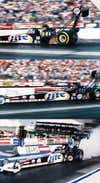0-300 in 4.5 seconds
Mechanically tuned and tweaked top fuel dragsters go like the devil's own wind-up toy. Here's a breakdown from amber lights to chute deployment.

Photographs by John B. Carnett
T minus 2 minutes: Racers back up into the waterbox, a wet section of asphalt behind the starting line, and hit the gas. The burnout heats and cleans the tires for better grip.
-0.4 seconds Drivers hit the gas when they see the amber light, sending the engine to 8,000 rpm.
0.0 The clutch, activated by a hydraulic timer, starts to transmit power to the wheels. The tires wrinkle from the torque.
0.1 Front wheels lift slightly off racetrack.
0.4 After the initial wrinkling, centrifugal forces balloon the spinning tires from 36 inches across to more than 43.
0.6 Drivers experience a maximum 4.5 Gs of force, roughly the same as what an astronaut feels during launch.
0.7 Speed and power can cause the tires to wobble uncontrollably. Internal timers retard engine’s timing, preventing loss of control.
0.9 Front tires touch down at 150 feet.
1.1 Front and rear spoilers provide downforce for traction, also flexing the chassis for more power to the rear.
1.2 The dragster is traveling more than 150 mph after passing the 200-foot marker.
1.5 Full timing is
restored to the cylinders.
2.5 The engine is now sucking 80 gallons of nitromethane per minute, which works out to one-tenth of a mile per gallon.
3.0 The five discs of the clutch are fully engaged, spinning at about 6,500 rpm.
3.5 At 650 feet, dragster hits 275 mph.
3.8 Weights on the centrifugal clutch are timed to release during the race, applying increasing pressure to the flywheel.
4.5 Vehicle clears the timing traps at roughly 330 mph. Driver pulls the chute, ready for 4.5 Gs of deceleration.